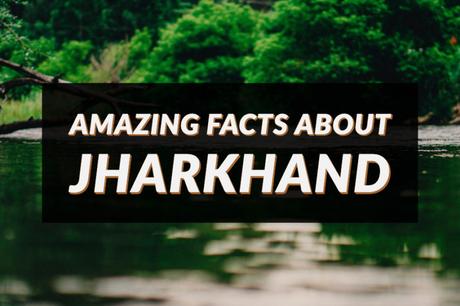
- Jharkhand was separated from Bihar on 15 November 2000.
- It is the 16th largest state by area and the 14th largest by population.
- The word 'Jhar' means 'bush' and 'Khand' means 'land' in the Indo-Aryan language. Thus 'Jharkhand' means 'land of bush or forest'.
- The state stretches over an area of 79,710 sq km (30,778 sq mi).
- One-third of the total area of the state is covered under forest.
- Ranchi is the capital city while Dumka is the sub-capital and Jamshedpur is the Industrial Capital of the state and also the largest city in the state.
- Most part of the state lies on the Chota Nagpur Plateau.
-
Jharkhand accounts for more than 40% of the mineral resources of India. Some of the minerals found in the state are Iron Ore, Uranium (Jaduguda Mines), Coal, Copper Ore, Mica, Bauxite, Manganese, Limestone, China Clay, Fire Clay, Graphite, Kainite, Chromite, Asbestos, Thorium, Sillimanite, and even Gold (Rakha Mines) and Silver.
- The state shares its border with 5 states; Bihar to the north, Uttar Pradesh to the northwest, Chhattisgarh to the west, Odisha to the south and West Bengal to the east.
- The state animal is Elephant, the state bird is Asian Koel, the state flower is Palash and the state tree is Sal.
-
Jaduguda Uranium Mine located at Jadugora is the first Uranium Mine of India which started its operations in 1967 and the deposits at this mine was discovered in 1951. Uranium Corporation of India (UCIL), a centrally owned Public Sector Undertaking (PSU), under the Department of Atomic Energy for Uranium Mining and Uranium Processing was founded in 1967 and is responsible for the mining and milling of uranium ore in India.
-
Tata Steel Ltd, the largest private sector steel and the second largest steel company in India, was founded by Sir Jamsetji Nusserwanji Tata in the year 1907 in Jamshedpur.
-
Bokaro Steel Plant (BSP), located in Bokaro is the fourth integrated public sector steel plant in India. It was established as a limited company in 1964 and later merged with the Steel Authority of India Limited (SAIL), the largest steel producer in India.
-
Jamshedpur is the first planned industrial city in India.
-
Adityapur, the sister city of Jamshedpur, now considered as a part of the Greater Jamshedpur Metropolitan Region once held the record of being the Largest Industrial Belt In Asia.
-
Dhanbad is also known as India's coal capital. Which is one of the most underrated facts about Jharkhand.
-
Baidyanath Jyotirlinga Temple, also known as Baba Baidyanath Dham, located in Deoghar is one of the twelve Shiva Jyotirlingas.
-
Betla National Park, established in 1974 is one of the largest Tiger Reserve and was one of the first national parks in India to become a tiger reserve under Project Tiger.
-
Lodh Falls / Budha Ghagh Falls, located in the middle of the forest in the Latehar district of the Chota Nagpur Plateau, is the highest waterfall in Jharkhand and ranks 21st in India.
-
Hundru Falls, located in the Ranchi district is the 34th highest waterfall in India.
-
Trikut Hill Ropeway, also known as Gagan Khatola, located at a distance of 20 km from Baidyanath Temple, is India's Highest Vertical Ropeway with the maximum lens angle of 44 degrees.
-
Maithon Dam and Lake, constructed on Barakar River and located in Maithon, is the largest dam in Jharkhand.
-
Netarhat, a town in the Latehar district also as the 'Queen of Chotanagpur', is a popular hill station in the state.
-
Parasnath is the highest mountain peak in the state with a height of 1365 m. The hill also known as Sri Sammed Shikharji is the most auspicious Siddha kshetra Tirtha or site of moksha among the Jains.
- The 'Kikat' Pradesh mentioned in the Rig Veda is located in the Parasnath Hills in Giridih district, Jharkhand.
-
Swarnarekha River / Subarnarekha River also knows as the River of Gold is said to carry traces of gold along with as the river originates from near a Gold mine at a village named Piska near Ranchi.
-
Tagore Hill located at Morabadi in Ranchi is a historical place where Rabindranath Tagore used to write poems inspired by the serenity and the beauty of the surrounding.
- The main festivals of the state are Karam, Jitia, Nawakhani, Sohrai/Bandna/Diwali, Phagua, Dussehra, Tussu, Vaha, Sarhul and Mage Porob.
- The Staple foods are rice, dal, vegetable, and tubers. The traditional alcohol is Rice Beer locally known as Handi or Handia.
- Some of the top institutes of India located in Jharkhand are Indian Institute of Information Technology (IIT) - Ranchi, Indian Institute of Management (IIM) - Ranchi, Indian Institute of Technology (Indian School of Mines) (IIT-ISM) - Dhanbad, National Institute of Foundry and Forge Technology (NIFFT) - Ranchi, National University of Study and Research in Law - Ranchi, National Institute of Technology (NIT) - Jamshedpur, St. Xavier's College - Ranchi, Xavier Institute of Social Service (XISS) - Ranchi, Xavier Labour Relations Institute (XLRI) - Jamshedpur, Indian Institute of Agricultural Biotechnology - Ranchi, Birla Institute of Technology (BIT) - Mesra, Ranchi, Birla Institute of Technology (BIT) - Sindri, Dhanbad, Central Institute of Psychiatry - Ranchi and many more.
Also, there are amazing places in Jharkhand like Domuhani, Dimna, Hathi Kheda Temple, etc which are must visit for any travel lover.
Do share your thoughts about the facts in the comment section.

